Insects
Dragonflies
Due to their size, their colourfulness and their conspicuous way of flying, dragonflies probably catch the eye of every attentive observer in the water-rich landscape of the Biosphere Reserve. Dragonflies are closely tied to biotopes in which their reproduction is possible. The type of water body preferred for reproduction is species-specific. In addition to flowing water species, species of still waters as well as species that depend on temporary waters can be found. In contrast to the damselflies (Zygoptera), the more flight-active dragonflies (Anisoptera) are able to cover greater distances and can thus be found far away from bodies of water.
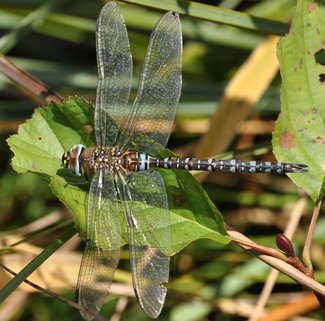
About 80 dragonfly species have been recorded in Germany so far. In the Schaalsee landscape, a total of 50 dragonfly species have been recorded. Of these, 36 species are classified as at least "endangered" according to the Red Lists of Mecklenburg-Vorpommern, Schleswig-Holstein or Germany.
Of special and supra-regional importance are marshland areas where highly specialised and partly highly endangered species occur.
These include e.g. dark whiteface (Leucorrhinia albifrons), white-faced darter (Leucorrhinia dubia), large white-faced darter (Leucorrhinia pectoralis), subarctic darner (Aeshna subarctica), common hawker (Aeshna juncea) and yellow-spotted emerald (Somatochlora flavomaculata).
At the Schaale, Schilde and Hammerbach streams, for example, the beautiful demoiselle (Calopteryx virgo) and the banded demoiselle (Calopteryx splendens) are found.
Grasshoppers

Only a few species, such as the lesser marsh grasshopper (Chorthippus albomarginatus), the meadow grasshopper (Chorthippus parallelus) and Roesel's bush-cricket (Metrioptera roeseli) are found in almost all open habitats in the Biosphere Reserve.
Among the wetland-loving species, the short-winged conehead (Conocephalus dorsalis), the slender ground-hopper (Tetrix subulata) and the large marsh grasshopper (Mecostethus grossus) deserve special mention.
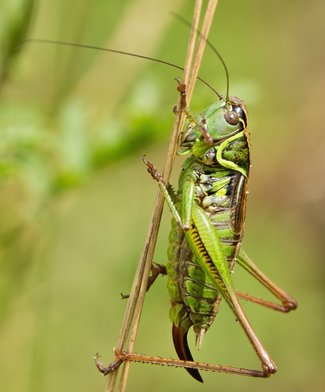
For dry habitats, such as dry grasslands, ruderal meadows, gravel pits, sand extraction sites, sun-exposed forest edges, the blue-winged grasshopper (Oedipoda caerulescens), the grey bush cricket (Platycleis albopunctata), the wart-biter (Decticus verrucivorus), the stripe-winged grasshopper (Stenobothrus lineatus), Corthippus mollis and the mottled grasshopper (Myrmeleotettix maculatus) are worth mentioning.
The European field cricket (Gryllus campestris), which is almost extinct in northern Germany, was last recorded in the early 1990s.
Moths
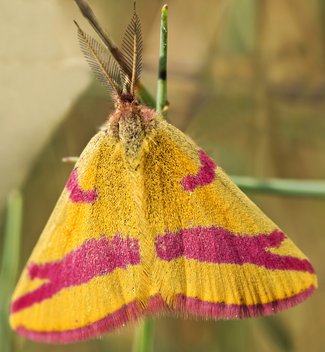
Moths colonise a large number of different habitats. The range of caterpillar food plants is very wide. These include rushes, sedges, reed canary grass, reeds and bulrushes, which are not very attractive to moths. In the course of special studies, about 475 moth species have been identified in the Biosphere Reserve so far. The identification of the individual species is only possible for specialists, since most of them do no have a common name in German.
Particularly noteworthy on a supra-regional scale are the records of some highly endangered moorland species such as Arichanna melanaria, whose caterpillars live on bilberry (Vaccinium uliginosum), or Amphipoea lucens and Celaeana haworthii, whose caterpillars prefer cotton grasses.
In drier habitats, several remarkable species living on broom were found (Chesisias rufata, Pseudopterna pruinata and Scotopter mucroptera), among others.
The wet grassland areas and reedbeds are also characterised by a large number of characteristic, stenotic and nationally highly endangered species. Phragmataecia castaneae, Senta flammea and Archanara dissoluta should be highlighted here.
Butterflies
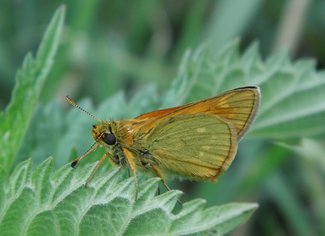
Due to their close dependence on different habitat qualities, butterflies react sensitively to habitat changes and are good indicators for the ecological assessment of landscapes. The most important habitat types for the butterfly fauna in the Schaalsee area are dry grassland habitats, bog areas, some wet meadows as well as sparse open forest areas with well-developed edges and margins.
A total of 46 butterfly species and three cygaenid species (rams) have been recorded in the Biosphere Reserve so far. Among them are 19 species that are considered 'endangered' in the Red Lists of Mecklenburg-Vorpommern or Schleswig-Holstein and ten species that are included in the Red List of the Federal Republic of Germany. Among the butterflies of the wetlands and moors, the occurrence of the highly endangered species northern chequered skipper (Carterocephalus silvicolus), northern chequered skipper (Hesperia comma) and large heath (Coenonympha tullia) is particularly noteworthy.
Glanville fritillary (Melitea cinxia), scarce copper (Lycaena virgaureae) and grayling (Hipparchia semele) are bound to drier sites. They require largely open, sun-exposed sites with site-typical caterpillar food plants and an extensive range of flower-rich vegetation.
Only a few records of the silver-washed fritillary (Argynnis paphia), the purple emperor (Apatura iris) and the white admiral (Limenitis camilla) have been found in the Biosphere Reserve so far.
Xylobiont Beetles
In the course of their evolution, a certain part of the beetles has specialised in the utilisation and exploitation of the raw material wood. These are the xylobiont beetles. The majority of xylobiont beetles are thus bound to the presence of certain tree species and to wood in various stages of decay. Thus, many species are dependent on the presence of special structures, on special microclimatic conditions, on a certain degree of decomposition or on certain animal burrows in the wood. Numerous beetle species are also bound to special fungi, their mycelia or fruiting bodies.
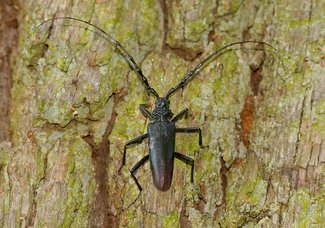
Due to the often very strong specialisation, the occurrence of certain species in a forest area has a great significance. These beetles are indicator species for the quality of the forest, for the variety of wood substrates available and thus for the degree of unspoilt nature of the forest. Xylobiont beetles are therefore ideally suited for assessing forest habitats. The xylobiont fauna recorded so far harbours numerous species typical of deciduous forests. By far the most important tree species are beech and oak. There are 44 endangered species of beech alone. So far, around 520 xylobiont beetle species have been recorded in the Biosphere Reserve. Particularly rich in species are the rove beetles (Staphylinidae), bark beetles (Scolytidae), sap beetles (Nitidulidae), minute tree-fungus beetles (Cisidae), silken fungus beetles (Cryptophagidae), minute brown scavenger beetles (Lathridiidae) and longhorn beetles (Cerambycidae).
Ground Beetles
So far, 135 ground beetle species have been found in the Biosphere Reserve, which corresponds to about 43 % of the species found in Mecklenburg-Vorpommern. 16 species are listed in the Red List of Mecklenburg-Vorpommern. Investigations carried out show that especially the ground beetle fauna of the wetland habitats in the Schaalsee area is represented with high numbers of species.
Agonum ericeti and Bembidion humerale should be mentioned as very stenotopic and at the same time highly endangered species of marshlands. Examples of predominantly hygrophilous species showing preferences for swamps, boggy soils, for birch, alder or willow forests, moist clay soils or muddy habitats in deciduous forests are Blethisa multipunctata, Epaphius rivularis, Badister dorsiger, Badister collaris and Stenolophus mixtus.
Among the notable species of dry and warm habitats (sun-exposed grasslands, semi-arid grasslands, sandy or gravelly riparian areas and sand pits), Ophonus signaticornis, Dyschirius angustatus, Carabus convexus and Panagaeus bipustulus stand out.